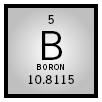Boron

MELTING POINT:
2,300°C
BOILING POINT
: 2,550°C
DENSITY
: 2.46g cm
3
MOST COMMON IONS
: B
3+
Boron occurs in nature as part of oxygenated compounds, or borates, that have been known since ancient times for their use in glass and metal production. In 1808 Joseph-Louis Gay-Lussac and Louis Jacques Thenard of France and Humphry Davy of England discovered the element boron almost concurrently. Another century passed before boron was successfully isolated in pure form. Elemental boron in its amorphous form is a dark brown powder; it is a yellowish-brown, hard, brittle solid in its monoclinic crystalline form. It melts at 2,300°C (4,172°F). Boron is unreactive to oxygen, water, acids, and alkalis. Boron compounds burn yellow-green during the flame test.
There are 217 minerals that contain the element boron but few are found in great enough quantities to make them commercially valuable. The few that are found in some quantity are white in color. Some boron-containing minerals, their percentages of boron, and the countries of their production in 2000 are: colemanite (51%), the United States and Turkey; datolite (25%), Russia; kernite (51%), Turkey and the United States; probertite (50%), Turkey and the United States; tincal (36%), Argentina, Turkey, and the United States; and ulexite (53%), Argentina, Bolivia, Peru, Turkey, and the United States. From these minerals, chemical compounds such as borax (sodium borate) and boric acid of various grades are manufactured. These compounds are clear or white. Commercial products, in order of the total quantity of boron consumed, are: fiberglass, borosilicate glass, soaps and detergents, fertilizers, enamels, fire retardants, and alloys .
Sodium borohydride is marketed in powdered or pellet form, and in solution, for use in fuel cells. Boron nitride can withstand temperatures of up to 650°C (1,202°F); when subjected to high pressures and temperatures, it forms cubic crystals whose hardness rivals that of diamond. Boron carbide, produced by reacting coke and boric acid at 2,600°C (4,712°F), is a highly refractory material and one of the hardest substances known. It has both abrasive and abrasion-resistant applications, and is used in nuclear shielding.
SEE ALSO Davy, Humphry ; Gay-Lussac, Joseph-Louis ; Nuclear Chemistry .
Phyllis A. Lyday
Bibliography
Garrett, Donald E. (1998). Borates: Handbook of Deposits, Processing, Properties, and Use. New York: Academic Press.
Lyday, Phyllis A. (1985). "Boron." In Mineral Facts and Problems: U.S. Bureau of Mines Bulletin 675. Washington, DC: Government Printing Office.
Comment about this article, ask questions, or add new information about this topic: